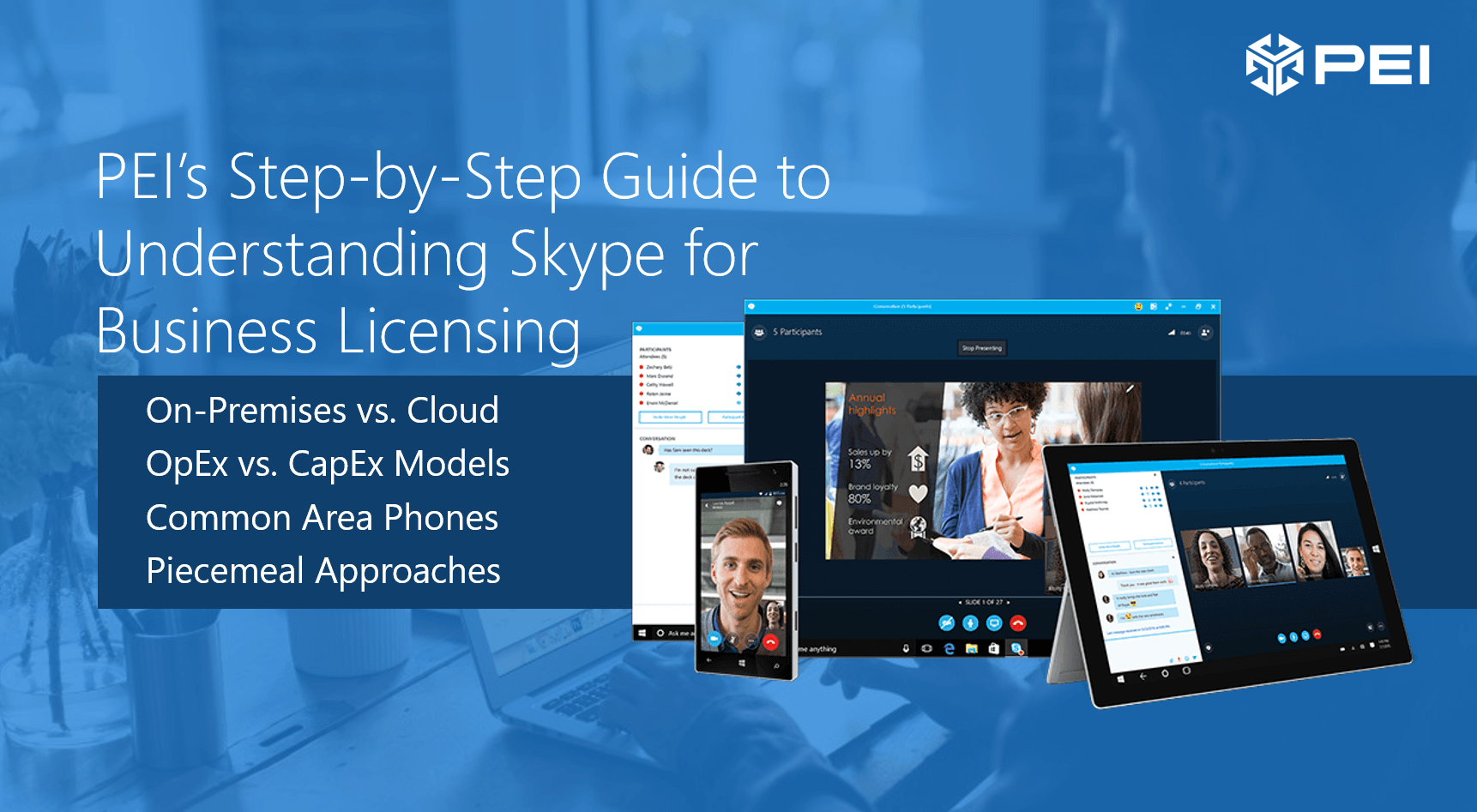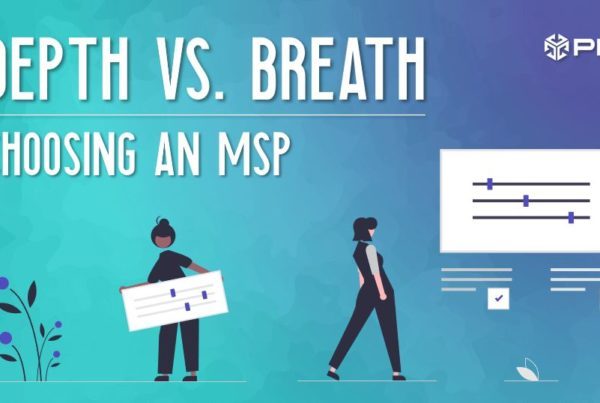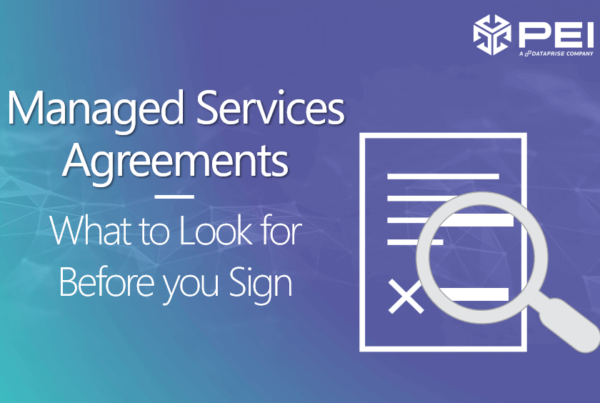
Microsoft Teams has now completely replaced Skype for Business as the communication and collaboration app for Office 365. Please see our guide on Teams licensing for the most up-to-date information about Microsoft Phone System solutions and licensing.
Last year I wrote this compilation of all the different ways Skype for Business could be licensed from the great deal of research I needed to perform constantly based on different client scenarios. This blog had a great deal of interest, and in classic Microsoft fashion, there have been a great deal of changes since it was posted, so I decided it’s time to update the content.
There are a number of ways to license Skype for Business/Teams for on-premises, hybrid, and cloud-based deployments. I’ve spent a great deal of time working with Microsoft to come up with the different options available for Skype for Business Licensing, so I’ll explain my findings and the best ways to leverage them.
Skype for Business Licensing for On-Premises Deployments
I’ll start out with a simple breakdown of all of the Client Access Licenses (CAL) for On-Premises deployments of Skype for Business (using list prices as of 2/15/2018):
- Standard CAL: enables users for Presence, IM, peer-to-peer VoIP, and HD Video
- Enterprise CAL: gives users the ability to schedule meetings for audio/video conferences with desktop and application sharing and dial-in conferencing
- Plus CAL: enables PSTN in/out, emergency calling, and other enterprise-grade phone features
- Skype for Business Client: allows users to download the local client onto PCs for leveraging the toolset. This comes with Office Pro Plus and other versions provided through Office 365 plans
Office 365 Skype for Business Licensing
Now we’ll look at the various plans available on a monthly subscription version through Office 365. Keep in mind, not all of these plans apply to both the On-premises and Online only solutions, which we’ll get into later:
- Skype for Business Online (Plan 1): Basic standalone plan for Skype for Business Online. This plan does not include the local client download, and users would need to use the web application version to access the features. In addition, it does not allow users to create and schedule Online meetings. This provides rights to the Standard CAL for on-premises deployments, and is included within the Office 365 Business Essentials, Business Premium, and Enterprise E1 plans.
- Skype for Business Online (Plan 2): All the functionality of the Skype for Business Online Plan 1, but also gives users the ability to create and initiate Skype for Business Online and on-premises meetings. Keep in mind, this doesn’t provide PSTN conferencing online, as that would require the PSTN conferencing add-on. It does however provide the licensing needed to schedule the PSTN conferencing if the organization has a 3rd party Dial-in Audio Conferencing solution (example: IntelePeer providing a SIP conferencing service). This subscription also does provide the local client so the users can use the full Skype for Business client.
- Microsoft Phone System (Previously Cloud PBX): provides the ability for a user to receive and transfer calls. They would be able to call any colleagues or peers also using Skype for Business, but would need an additional add-on to be able to make outbound calls using Microsoft as the PSTN calling provider. Phone System is available as an add-on SKU, or is included within the Office 365 E5 plan. In order to use the Phone System plan, the user needs an Enterprise Office 365 subscription (E1, E3, E5)
- Microsoft Calling Plan (Previously PSTN Calling): provides users the ability to make outbound calls using Microsoft as the voice provider. Calling Plan is available for purchase as unlimited domestic per user, unlimited domestic AND international per user, or consumption based if certain groups of users will be making fewer outbound callers
- Microsoft Audio Conferencing (Previously PSTN Conferencing): Provides the ability to create a Skype for Business Online meeting that contains a PSTN dial-in number for users to call into. This can be added to nearly all Office 365 subscriptions (including Business Premium or Skype for Business Online Plan 2 Standalone), but is also included with the Enterprise E5 plan
- Skype for Business Plus Add-on: This provides the same functionality as the Skype for Business Plus CAL for on-premises deployments of Lync/Skype for Business, but is provided in an OpEx approach similar to Office 365. This would be added to users with an E3 subscription in order to get the exact functionality that was provided by the Office 365 E4 plan.
There are a few other applicable add-ons, but this list is a relatively simple compilation of the most relevant features and plans available for Skype for Business Licensing. One thing that helps is to come up with different use cases that would help determine the best route to license users.
Example #1: Company has Skype for Business On Premises with Enterprise Voice and is using Exchange Online for Email.
In this case, the organization would need to have some sort of Office 365 subscription for the email functionality, but they have options for how to license Skype for Business. For a company with a preference for pure Operational Expenditures, this way would be the best route for their Skype for Business Licensing:
Office 365 E3 @ $23/user/month (which covers the Skype for Business Standard and Enterprise CALs) + the Skype for Business Plus CAL @$2/user/month. The Skype for Business Front End servers would still need to be licensed, but I’m just going to focus on end users.
If this organization preferred the Capital Expenditure model, then they would need to purchase Exchange Online Plan 2 (or another plan that leverages this subscription as the Exchange Online portion), as well as the Skype for Business Standard, Enterprise, and Plus CALs. This would be a mixture of the OpEx and CapEx models, but would still be more heavily CapEx, at least the Skype for Business side.
Example #2: Company has Skype for Business Online for Enterprise Voice and using Exchange Online for Email
In this case, the organization is relying entirely on Microsoft’s subscription-based services, which would be entirely OpEx. I will preface this with the caveat that I do NOT recommend this first approach, but if I’m breaking it down as granularly as possible, this is how it can be accomplished. With this in mind, here’s the piecemeal method of the various components needed to yield a pleasant user experience:
- Office 365 E1 – Base license that’s needed for other add-ons.
- Exchange Online (Plan 2) – Allows for email online and Plan 2 provides voicemail capabilities in Exchange Online
- Skype for Business Online Plan 2 – Provides the Skype for Business client
- Phone System Add On
- Calling Plan (Domestic, International, or Consumption)
- Audio Conferencing (if user will be scheduling conferences)
Starting from the itemized list can help determine the best way to package users. Let’s start from the high technology user approach, and license in the simplest model:
- Office 365 Enterprise E5 Plan @ $38/user/month (contains all of the following subscriptions)
- Skype for Business Online (Plan 2)
- Exchange Online (Plan 2)
- Phone System
- Audio Conferencing
- Calling Plan Add-on
- Domestic Unlimited @ $12/user/month
- Domestic & International Unlimited @ $24/user/month
- Consumption – Calculated based on country of origin, country of termination, etc.
If the organization only wants to call domestically, this puts the OpEx cost at $50/user/month. Keep in mind, that the Office 365 E5 subscription comes with a great deal of additional value on top of Exchange Online and Skype for Business Online. There’s a plethora of security and collaboration benefits that should be looked at before dismissing this as a viable option (Power BI, Advanced Threat Analytics, etc.).
For the same situation, certain organizations simply want their users to have the ability to send/receive emails, send/receive calls, and have local downloads of Office. These organizations may not need their users creating conference calls, and may not see value in the additional security components that come with E5. For these organizations, the below may be a better approach:
- Office 365 Enterprise E3 Plan @ $23/user/month (contains the following subscriptions)
- Skype for Business Online (Plan 2)
- Exchange Online (Plan 2)
- Phone System Add-on @ $8/user/month
- Calling Plan Add-on
- Domestic Unlimited @ $12/user/month
- Domestic & International Unlimited @ $24/user/month
Keeping consistent with going Domestic only for calling, this puts the organization at $43/user/month. This saves a bit on the E5 route, but for organizations that keep their email security and business intelligence needs outside of Microsoft, this may be the best route.
Non-Recommended (Though Possible) Methods of Skype for Business Licensing
I will preface that these remaining options are “technically” supported ways to license users, but I will say that we have never gone with any of these routes, as this adds massive amounts of complexity trying to understand how users are licensed and managed by the administrative team. I simply want to provide these options as they are possible, but they may not yield a desirable end user experience.
Calling and Email Functionality Plus Office Online Apps
If an organization has a user base that is very limited in its technology needs, there are a couple of options that would be a bit cheaper than the previous two routes. Again, I wouldn’t advise going this route, but in theory they are doable.
-
- Office 365 Enterprise E1 Plan @ $10/user/month
- Phone System Add-on @ $8/user/month
- Calling Plan Add-on
-
- Domestic Unlimited @ $12/user/month
- Domestic & International Unlimited @ $24/user/month
-
- Exchange Online Plan 2 @ $8/user/month (allows voicemail to be stored in Exchange Online)
This is not an ideal approach to Skype for Business licensing, as you would be paying for both Exchange Online Plan 1 and 2, and your users would still be unable to have local downloads of office (unless those have been previously purchased in something like Open Business or OEM). This option comes out to $38/user/month, and I would advise against going with this route. These users would still be able to use the online versions of the Office suite in case the organization needs them for editing/viewing documents and spreadsheets.
Cheapest Possible Licensing Combination to get Voice Solution
Getting someone at Microsoft to put this in writing was nearly impossible, but I have confirmed that it is possible to get the add-on SKU’s put onto just the Skype for Business Online Plan 2 standalone plan without the need of an Enterprise Plan. Here’s the breakdown of what that licensing looks like, should the client ONLY want Skype for Business for voice (without Audio Conferencing):
- Skype for Business Online – Plan 2 @ $5.50/user/month
- Phone System Add-on – $8/user/month
- Calling Plan Add-on
- Domestic Unlimited @ $12/user/month
- Domestic & International Unlimited @ $24/user/month
- Consumption plan option, using Communications Credits in a non-unlimited fashion
Keeping with Domestic calling, this puts the price at $25.50/user/month to have the ability to use Skype for Business Online to make and receive calls. This will provide users with the full local client of Skype for Business, as well as the ability to use a supported desk phone. One key piece that this DOES NOT include is the ability to use Voicemail, as that comes with Unified Messaging and requires Exchange Online Plan 2 in some form. If that is required (which it is in most cases), users will need that plan @$8/user/month, bringing the total to $33.50/user/month. When I look at the additional value that the E3 approach above provides for the additional $9.50/user/month, it becomes a no brainer to go with the E3 route.
Common Area Phones
For a common area phone that’s not a true Skype Room System, there are ways to provide functionality that does not require assigning a license. AudioCodes has provided information in their support forums stating “Common Area Phone (CAP) online support phones can now be defined as CAPs when using a cloud PBX. Defined per physical phone rather than per user, a CAP requires a special sign-in method called ‘CAP Provisioning’ exclusive to Cloud PBX. Before signing in, users must enable the phone as a CAP and then sign in using this special ‘CAP Provisioning’ method. CAPs in server mode are unchanged. The change applies only to Cloud PBX.”
Jeff Schertz has written a fantastic blog about how to assign the licenses and get them setup in your environment, found here.
As of March, 2018, Microsoft has finally released a dedicated SKU for Common Area Phones, coming in at $8/user/month, and is available within the Office 365 Admin portal under the “Other Plans” section. This should greatly simplify things, and allow the devices to show in the reporting and management toolsets. This license however still requires a calling plan if it needs to dial out, so if it will be used outside of simply joining Skype for Business Conference bridges, it will require a calling plan ($12/phone/month), making each phone $20/phone/month with the two licenses.
Skype for Business Voice and Microsoft 365
With the Microsoft 365 bundles available today, the complexity does not increase greatly. For the scenarios above, below are the impacts for organizations needing to leverage the full voice capabilities of Skype for Business Online:
- Microsoft 365 Business – Need to upgrade to the Enterprise options in order to provide the add-ons as of today
- Microsoft 365 Enterprise E3 – Need to purchase the Phone System, Calling Plan, and Audio Conferencing Add-ons for additional functionality
- Microsoft 365 Enterprise E5 – Need to purchase the Calling Plan for additional functionality
Microsoft Teams
With the onset and future of Teams, a great deal of focus is around planning the transition to Teams from Skype for Business Online, which many organizations are concerned about. Currently, Teams is available for Office 365 subscriptions, with enterprise voice capabilities available as well. There is a great deal available from a feature standpoint, with a great deal more scheduled to roll out in Q2 CY2018. The licensing is planned to be consistent with Skype for Business, so the above scenarios should hold true, but I will update accordingly. To see the roadmap, as well as all resources I’ve used to build this blog, please follow the links below or feel free to comment!
If you would like to discuss the licensing options further, I would be happy to discuss what I know. Just shoot an email to info@pei.com, and I’ll reach out to you directly.
Martin Feehan, Director of Client Relations, PEI
This blog was updated to reflect license price changes that Microsoft implemented on March 1, 2022.
-
Please See this List of Resources for More Information on this Topic:




